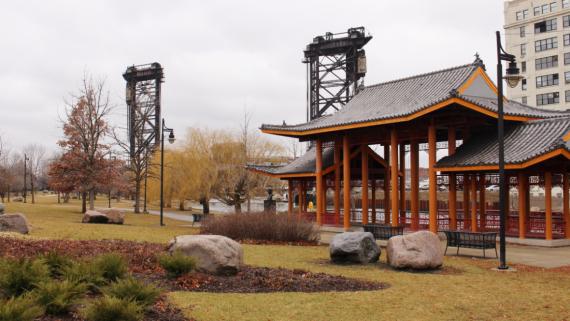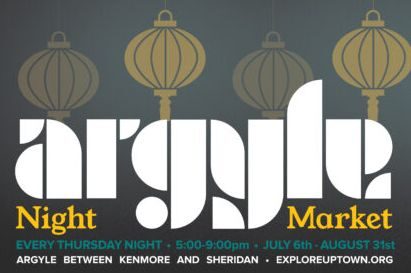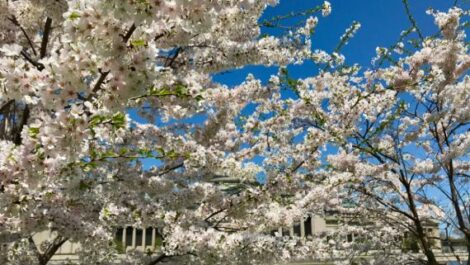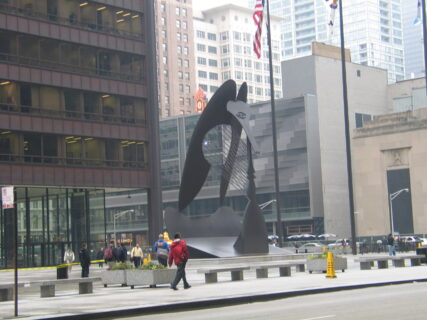*Ed note: The following article is a slightly condensed version of writer/ theater critic/ videographer Reno Lovison’s Podcast on becoming more familiar with Asians in Chicago. After hearing all the misunderstandings that occurred during and after COVID I believe more people should try to get to know their local Asian communities. Consider exploring their areas abroad. But also think local for a travel treat. Reno has included some of his favorite Asian eating spots in Chicago.

Asian is a rather broad term whose nations encompass all of the Asian continent including Eastern Asia with China, Mongolia, Japan, North and South Korea. South-East Asia includes the area of the Philippines, Vietnam, Indonesia, Thailand, Cambodia, Singapore, Malaysia, Laos, and others.
South Asia is the southern subregion of Asia, defined in both geographical and ethnic-cultural terms that commonly includes Bangladesh, India, Nepal, Pakistan, and Sri Lanka, with Afghanistan also often included.
Central Asia includes what are sometimes remembered as the “stan” countries of Uzbekistan, Kazakhstan, Tajikistan, Kyrgyzstan, and Turkmenistan, while Western Asia generally includes the countries referred to as the Middle-East with Turkey, Israel, Armenia and all of the Arabian Peninsula.
The Pacific Islands refer to all of Melanesia, Micronesia and Polynesia including our own Hawaiian Islands.
Forgive me for any omissions, this is not intended to be a comprehensive list rather I encourage you to do some research of your own as you consider your exploration of how the Asian culture has manifested itself within the Chicago experience.
The first Chinese who were mainly Cantonese speakers arrived in Chicago around the time the transcontinental railroad was completed on May 10, 1869. This was because a majority of the workers who laid the tracks were Chinese immigrants. Now, 43,228 individuals in Chicago identified as Chinese according to the 2010 census, represent 1.6% of the city’s population. About 10,000 ethnic Chinese reside within the historic Chinatown area.
I encourage you to look into the Asian American historical record by visiting the Chinese American Museum of Chicago at 238 West 23rd St. The museum can be a great jumping off point to explore the Chinatown area.

If you really feel adventurous, consider taking the Chicago Water Taxi from Michigan Avenue downtown to Ping Tom Park. There are spectacular views of the riverwalk and historic buildings along the way including the Willis Tower and the Opera House.
Now, I am no expert on Chicago’s Asian Community but I would like to share some of my own experiences from the point-of-view of a lifelong Chicago resident who has a relationship with the South-East Asia Center in Uptown.
This relationship has been an opportunity to appreciate the struggles of immigrants in general as well as the various cultures the organization serves.
Established about 40 years ago with a mission to help resettle individuals from South-East Asia after the Vietnamese conflict, the center has grown to serve not only South-East Asians but also other newly arrived immigrants including those from Russia, Somalia, Afghanistan, Latin America and more.
The Center currently has more than 40 languages spoken among staff and clients. Its ESL classes are an essential service that helps newly arrived immigrants learn, practice and improve their English language skills.
Becoming a volunteer ESL tutor only requires about two weekends of training and is an excellent way to get beyond the tourist approach and become more personally involved with people from other cultures. I have done it myself and have really enjoyed the interactions with my students and what I learned from them.
For those over 60, the South-East Asia Center hosts a Golden Diners Lunch Program Monday through Friday from about 11:30 to 1:30. This is one of a number of dining locations around the city that provide a pay-as-you-please lunch option for seniors.
The spirit of the program is not to provide low-cost meals but rather to encourage seniors to get out into their communities and interact with one another.
If you are a senior grab a friend and explore the city. You can find a list of locations at “Chicago Golden Diners Program.”
By the way, the building that houses the South-East Asia Center’s Golden Diners Program at 5120 North Broadway is a local landmark that was originally built as a German Beer Garden and stands as a testament to the ethnic changes that have taken place around the city. At this location you’ll typically be treated to a very traditional Vietnamese style meal.
There are also Asian meals offered in Chinatown at the Chinese Community Center, Korean faire on north Kedzie, and Indian and Pakistani options on Devon and on North California. The city’s Golden Diners website provides addresses and details.
While we are talking about this part of the city, I must mention the Argyle Street commercial area just east of Broadway that is easily accessible by the Redline.
Known as “Little Saigon,” this street is inviting to anyone who wants to experience South-East Asian culture with local stores and (no-kidding) about 20 restaurants that either feature Pho or have Pho in their name
For the uninitiated Pho (pronounced “fuh”) is a kind of broth with vegetables and meat typically served in a surprisingly large bowl. On a cold day you will manage to eat it all.
Other things to try might be Banh mi , a delicious baguette sandwich that reflects the country’s French colonial influence or steamed Bao, a pillowy soft steamed dumpling folded and filled with meat and veggies.
One of my favorites is the Vietnamese crispy savory crepe which is a cross between an omelet and French crepe folded and garnished with ample quantities of fresh herbs and greens accompanied by a sweet and pungent sauce.

Argyle Night Market, held every Thursday from 5 to 9 p.m. through August is a perfect time to experience the neighborhood and rub shoulders with the locals. Check out Explore Uptown.
Heading north and a bit west to Devon and Western will take you into the heart of “Little India,” the South Asian or Indo Pakistan area of the city where you can enjoy the sights and smells of this rich culture.
The street is festooned with nearly a mile of colorful sari shops and local markets where you can pick up fresh spices like saffron, turmeric and more.
This area is purported to have some of the best Indian restaurants in the country. Ask virtually any person throughout the South Indian diaspora and they will likely tell you they have a brother or cousin who lives here.
Food is of course the gateway to experiencing any culture so I’ll just give you a few of my favorite spots. I am not saying they are necessarily the best in category but they will provide a place for you to begin your personal exploration and encourage you to get out into some of Chicago’s northside ethnic neighborhoods. I have often said you can explore the world by exploring Chicago.
For Thai cuisine we typically default to Tiparo’s just south of North Avenue on Clark Street. We usually split one Tofu Pad Thai and one Crazy Noodles with Chicken. The portions are big enough for us to get two meals apiece out of an order of each to go.
Reza’s in Andersonville, a popular spot for Persian dining, features various skewers of grilled meat served on a bed of dill rice. Next door, Andie’s Mediterranean, has a large menu with a number of delicious vegetarian options.
At Foster and Clark is the Middle East Market where you can pick up an assortment of foods ideal for tasty lunches or light suppers. My stop there recently included a few spinach and cheese pies, a few parsley and cheese pies with kalamata olives, some veggie topped flat bread, a half-dozen falafel, hummus with roasted garlic, and some pita, feta cheese and kalamata olives to supplement other home cooked meals.
Staying within the western Asian cuisine, a little to the west on the other side of Rosehill Cemetery at a point known as the bend at the corner of Maplewood and Lincoln, is the Shawarma Inn purported to have the best (and in this case I agree) shawarma in the area.
If you are not familiar, shawarma is sirloin beef cooked rotisserie tyle and thinly shaved, served over rice or as a pita sandwich. Their hummus is also exceptional.
For the record this area is home to a large Assyrian population. The Assyrian civilization at one time incorporated the entire Near East, most notably the area of the Fertile Crescent or Northern Mesopotamia.
The heartland of Assyria lies in present-day northern Iraq, southeastern Turkey, northeastern Syria, and northwestern Iran. The remains of the ancient capital of Assyria, Nineveh, lies within Mosul in northern Iraq.
A great place to learn more about this culture would be the University of Chicago’s Oriental Institute in Hyde Park. (Known now as the Institute for the Study of Ancient Cultures).

It is not far from the Museum of Science and Industry where you will find Japanese Gardens along the lagoon. This stunning spot with its iconic bridge and cheery trees was originally created by the government of Japan for the 1893 World’s Columbian Exposition. Reconstructed and renamed officially as the Garden of the Phoenix. A prominent feature as of 2016 is a sculpture entitled “Sky Landing” by acclaimed artist Yoko Ono.
Back up north, Bryn Mawr between Kedzie and Kimball, is traditionally the Korean neighborhood, but I have enjoyed Midori for Japanese food in this neighborhood at 3310 W. Bryn Mawr Ave.
When it comes to Korean food, I have to give the nod to Soon at Noon Hour Grill at 6930 N. Glenwood in Rogers Park. Soon introduced me to bi bim bop about 30 years ago and I have judged every experience with that dish against hers ever since. This restaurant also has easy access via the red line Morse stop.
For some quick casual Filipino food, I like Merla’s Kitchen at Foster and Kimball. Her chicken adobo is well respected and her handmade empanadas made to order are large fresh, fried on the spot and delicious. It may take a little time but it will be worth the wait.
I believe a little-known gem is Jibek Jolu, a casual, family-run Kyrgyzstan eatery at 5047 N. Lincoln Ave. which serves hearty Central Asian fare. In my opinion this is literally where East meets West and those of us with Eastern European traditions will find some familiar looking and tasting options with a distinct Asian twist.
This Chicago Asian community overview is hardly comprehensive but I hope it will whet your appetite and encourage you to experience some new or different cultures.
Please go beyond the simple tourist approach of eating and gawking. Find some way to get involved in the important process of connecting with other people. Invite a friend or neighbor from a different ethnic group to join you on your expedition or be your guide. Do the same for them. Enjoy your differences but pay attention to your similarities and make note of the many things we all have in common.
Reno Lovison is the executive producer of Chicago Broadcasting Network.

